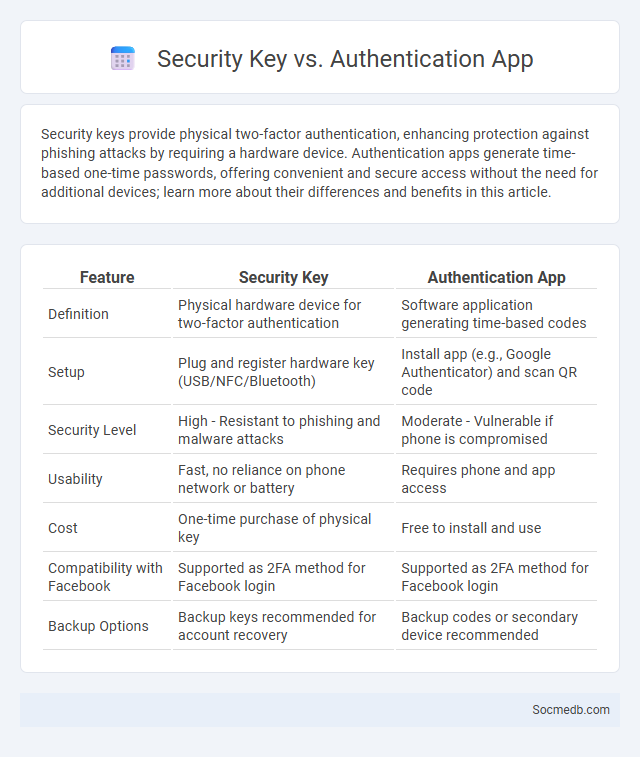
Photo illustration: Security Key vs Authentication App
Security keys provide physical two-factor authentication, enhancing protection against phishing attacks by requiring a hardware device. Authentication apps generate time-based one-time passwords, offering convenient and secure access without the need for additional devices; learn more about their differences and benefits in this article.
Table of Comparison
| Feature | Security Key | Authentication App |
|---|---|---|
| Definition | Physical hardware device for two-factor authentication | Software application generating time-based codes |
| Setup | Plug and register hardware key (USB/NFC/Bluetooth) | Install app (e.g., Google Authenticator) and scan QR code |
| Security Level | High - Resistant to phishing and malware attacks | Moderate - Vulnerable if phone is compromised |
| Usability | Fast, no reliance on phone network or battery | Requires phone and app access |
| Cost | One-time purchase of physical key | Free to install and use |
| Compatibility with Facebook | Supported as 2FA method for Facebook login | Supported as 2FA method for Facebook login |
| Backup Options | Backup keys recommended for account recovery | Backup codes or secondary device recommended |
Introduction to Digital Authentication Methods
Digital authentication methods use advanced technologies such as biometrics, two-factor authentication, and OAuth protocols to secure social media accounts from unauthorized access. Your online identity is protected by encrypting login credentials and verifying user authenticity through unique identifiers like fingerprints or one-time codes. These methods enhance security, reduce fraud, and maintain trust across social media platforms.
What is a Security Key?
A security key is a physical authentication device used to enhance online account protection by enabling two-factor authentication (2FA). It generates unique cryptographic codes, preventing unauthorized access even if passwords are compromised. Popular security keys, such as YubiKey and Google Titan, support protocols like FIDO U2F and WebAuthn for seamless integration with major social media platforms.
Authentication Apps: How Do They Work?
Authentication apps generate time-based one-time passwords (TOTPs) that enhance security by requiring You to enter a unique code along with your regular login credentials. These apps synchronize with services like Google, Microsoft, and Facebook using a secret key, ensuring that the generated codes are valid only for a short period. Using authentication apps significantly reduces the risk of unauthorized access caused by compromised passwords on social media accounts.
Overview of Two-Factor Authentication (2FA)
Two-Factor Authentication (2FA) enhances social media security by requiring two separate forms of verification, typically a password and a code sent to your mobile device, to access accounts. This additional security layer significantly reduces the risk of unauthorized access, protecting your personal information from hackers. Implementing 2FA on popular platforms like Facebook, Instagram, and Twitter is essential for safeguarding your online presence.
Security Key vs Authentication App: Key Differences
Security keys provide a physical device for two-factor authentication, enhancing your social media account protection by requiring a USB or NFC-enabled key for login. Authentication apps generate time-based one-time passwords (TOTPs) on your smartphone, offering a convenient and widely supported method to verify your identity. Choosing between security keys and authentication apps depends on your preferred balance between security level and ease of access for social media account safety.
User Experience and Convenience Comparison
Social media platforms prioritize user experience by offering intuitive interfaces and personalized content algorithms that enhance engagement and ease of navigation. Convenience features such as seamless cross-device syncing, in-app messaging, and integrated multimedia sharing streamline communication and content consumption. Platforms like Instagram and TikTok excel in delivering visually rich, fast-loading feeds, while Facebook provides robust group interactions and event management tools, catering to diverse user needs.
Security Strength: Which Method Offers Better Protection?
Social media platforms employ various security measures, but multi-factor authentication (MFA) offers stronger protection by requiring multiple verification steps beyond just passwords. Your accounts are significantly more secure when MFA is enabled, reducing the risk of unauthorized access from phishing or hacking attempts. Advanced encryption protocols and regular security updates further enhance protection, but MFA remains the most effective method to safeguard your personal information.
Compatibility and Integration with Online Services
Social media platforms excel in compatibility by supporting multiple devices and operating systems, ensuring seamless access across smartphones, tablets, and desktops. Integration with online services like e-commerce, cloud storage, and CRM tools enhances user experience and streamlines business operations. APIs provided by platforms such as Facebook, Instagram, and Twitter facilitate smooth data exchange and cross-platform functionalities, driving engagement and operational efficiency.
Pros and Cons of Each Authentication Method
Social media platforms employ various authentication methods such as passwords, two-factor authentication (2FA), biometric verification, and social login, each with distinct pros and cons. Passwords offer simplicity but are vulnerable to hacking, while 2FA enhances security through a secondary code but may inconvenience users; biometric methods provide seamless access yet raise privacy concerns, and social login speeds up account creation but risks data sharing with third parties. Understanding these authentication options helps you balance security, privacy, and convenience for your social media accounts.
Choosing the Right Authentication Method for You
Choosing the right authentication method for your social media accounts is crucial to secure your personal information and prevent unauthorized access. Multi-factor authentication (MFA), such as SMS codes, authenticator apps, or biometric verification, significantly enhances account security by requiring multiple verification steps. You should evaluate each platform's available options and select the method that balances convenience and security based on your specific needs.
 socmedb.com
socmedb.com